I see Paris, I see France, and from the shores of Helsingør in Denmark, by the Shakespearean Hamlet Castle (Kronborg Slot if we’re getting technical) I see Malmö, Sweden.
On this trip, I’m actually not headed to Malmö— despite the urge to hop the ferry. Instead, I’m grabbing a quick flight across the Baltic Sea from Copenhagen to Stockholm.
Upon landing in Stockholm, I settle into my hotel. On this leg, I’m staying at The Sparrow located in Östermalm on one of the busier streets of Stockholm.
This hotel came recommended to me by a travel agent from FORA. Sidebar—I’ve never used a travel agent before. I normally rely on my instincts, exceptional online boutique hotel sleuthing, and taste. This time, I wanted to alleviate some of the itinerary planning and they were super helpful.
Happy to share more about my experience with FORA in a separate post for those who are interested
I opted for this hotel because I instantly fell in love with its’ 19th century architecture, quaint courtyard, stunning elevator, and highly rated food. Its central location also means I’m in the heart of the action without feeling overwhelmed by city noise thanks to the tasteful and soundproof design.
The Sparrow has a French twist supported by Scandinavian minimalism and practicality. Rooms are quiet, luxurious, and beautifully functional. My room is front-facing with large windows hosting a small bed of flowers on a Juliette balcony where I have coffee in my robe and slippers taking in the view.
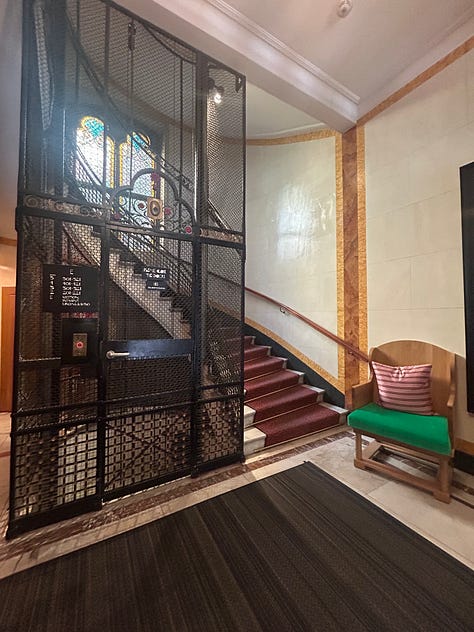
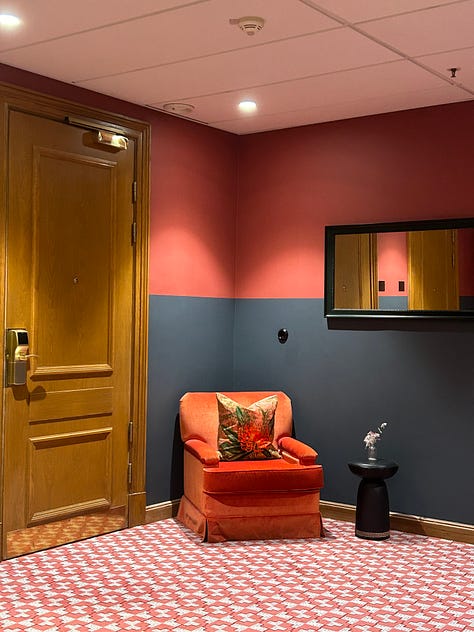
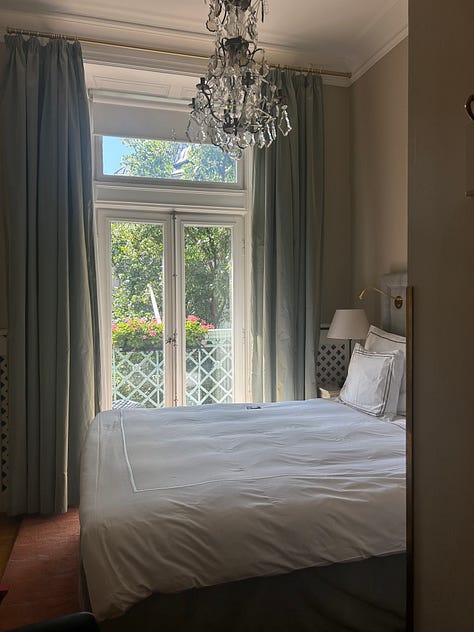
After an easy check-in I find my way to the harbour where I snag a seat on a boat sipping an Aperol Spritz.
Stockholm is made of a series of archipelagoes and is one of the largest (if not the largest) city in Europe. It feels big given the amount of people walking the busy harbourfront separating the old town from the newer districts. The shopping here is so much fun. I venture to the old town for vintage shopping where oversized leather bomber jackets are flying off the rack faster than Gen Alpha can say skibidi.
I end up in a treasure trove at Sneakersnstuff where my indecision gives way to three different pairs of kicks, each one far more comfortable than the shoes I arrived in.
With forboding clouds approaching and a satisfied decision of Adidas originals in green and yellow, I hop a Lime scooter and make it to the Fotografiska museum. The museum is set in an old warehouse building with stunning views of the Stockholm skyline and harbourfront, a ferry transports people to and from the old town and I make a mental note to grab it on my way back.
Fotografiska of course is the inspiration of New York’s late membership and culture hub of artists, photographers, movers, and shakers. It’s no wonder when you consider the caliber of exhibits that the museum hosts. Today, I’ve made it just in time for Banksy’s exhibit one that I’ve admittedly already experienced once in Amsterdam, and again in Toronto. But there’s more to the museum than Banksy’s work (which is still brilliant). I venture to their more permanent collection and find myself in the agriculture section. I note the self-sustaining garden promoting the importance of knowing where our food comes from.
The emphasis on sustainable practices is certainly not lost in Stockholm, much like their Danish neighbors. There’s a fine point put on overconsumption and a nod of gratitude to the natural wonders of the world. I look out the window and as if right on queue, a sealion preying (or playing?) with a seagull pops his head up.
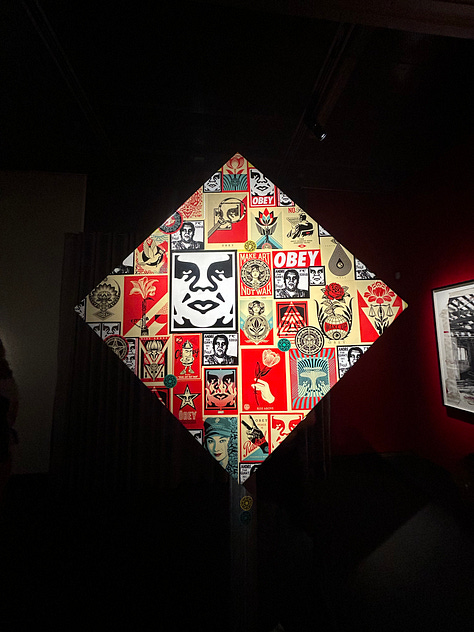
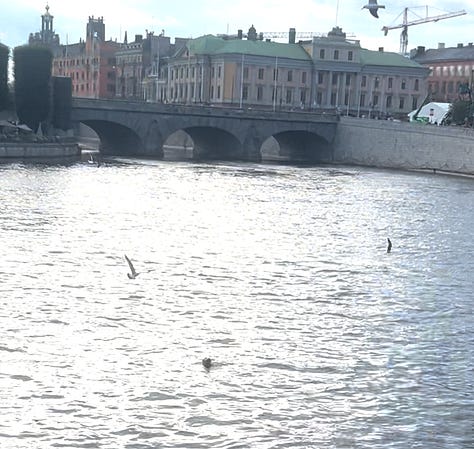
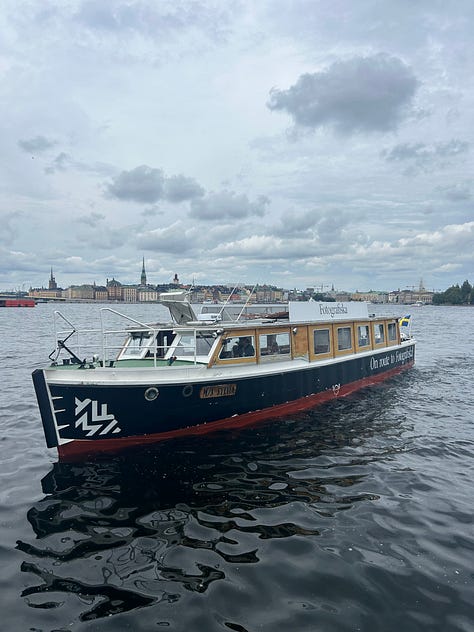
Life imitates art, I think to myself, grabbing the ferry across the sea back to the new town to deposit my shopping bags and make my dinner plans.
French pop music guides my way through the Parisian-style wallpaper-lined walls at The Sparrow and leads me toward a white gravel courtyard. Edison bulbs hang from a canopy that shields from impending rain. I’m grateful that the rain has held off and the evening summer heat is tolerable for an apéro outside.
The menu at The Sparrow is designed by chef Mathias Dahlgren. It aligns itself well with community ideologies of Scandinavian dining while also emphasizing a brilliantly relaxed French menu. I have the steak frites and a cold glass of rose from Provence.
It’s not the most Swedish meal but it hits perfectly after a day of exploring.
The following morning I have breakfast in the courtyard again, this time taking in the design of kitchen flatware from Sagaform. I’m in love with my hotel’s design style and ask the front desk if the mugs are purchaseable. A straightforward and not-altogether-mean-just-very-Swedish ‘no’ is the response. I make a mental note to shop some homeware and eat another mini Madelaine before mapping out the day’s adventures.
Evaluating Google Maps, a tap on the shoulder from another hotel guest snaps me back to the present moment. An art historian professor named Anne introduces herself. I’m thrown into a parallel universe of what it could have looked like had I pursued a fine arts degree in college. She acknowledges that I’ve been sorting through which museums to visit and shares her recommendations. What a gift to be able to see the world of art, architecture, and culture through the eyes of someone with so much knowledge.
With Anne’s suggestions in tow, I head out into the sun and throngs of tourists. Today, I press on towards Museum Island. Here I’m told to see a shipwreck preserved from over 400 years ago. The building itself is shaped like a sinking vessel and is immense. Its grandiosity is only exaggerated once you walk in and note the overwhelming presence of the rescued wreck built in the 1600s.
The aura of this thing is out of control and the museum tells the story of how it was built, the people who built it, and the tragic reasons it sank. It’s an incredible piece of history that the Swedes are notably very proud of— for good reason.

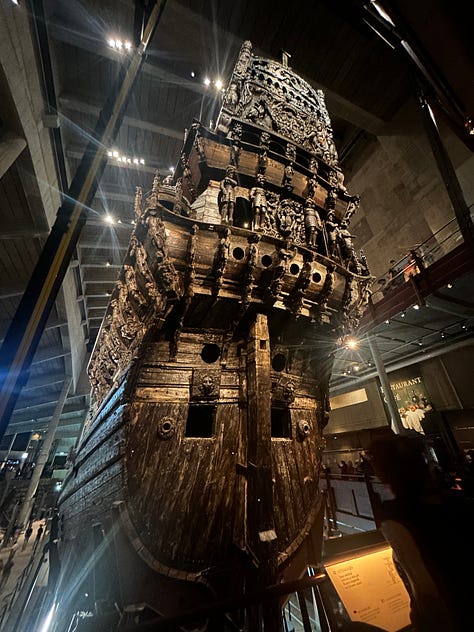

As I leave Museum Island I’m heading for a snack of Swedish fish and licorice before jumping on a boat ride to explore more archipelagos. Navigating the summer waters of Stockholm the breeze feels nice and the landscape and natural beauty are pleasantly surprising.
We count over 27 swans in a flock resembling synchronized swimmers. Swedish summer homes inspire a sense of simplicity and artistry, landscapes drenched in history from Russian invasions, and of course a moment for a few pop culture references as we pass by a home where Abba wrote many of their hit singles.
Docking the boat, passengers hop off like little clowns descending from a Volkswagen. I head to Brasserie Astoria for lunch, an appreciated recommendation from a chef I met in Hamburg. Escorted up a spiral staircase with a truffle light fixture hanging from the center, I sit comfortably while hibiscus lemonade and seafood toast (toast with king crab, shrimps, and lemon cofit and wasabi oil—delightful) find their way to my table.
The day is still young and I’ve walked over 20k steps, a well-earned lunch feels perfect.


A few people pass by and I note their tote bags are designed with a familiar logo. I can’t quite place it, is it a brand? No. But I’ve seen it before—then it dawns on me. It’s not a logo, it’s the silhouette of Avicii the late DJ. Or as we’ve come to know him as Tim in the recent Netflix documentary ‘My name is Tim’.
I ask one of the strangers why so many people seem to have the same tote bag and he mentions there’s a pop-up exhibit paying homage to Avicii in the city center not too far away.
A newfound pep in my step walks me towards the Avicii Experience where the outside resembles the entrance to a rave, the distinct and loud melody of Levels can be heard from outside. Walking in, Avicii’s DJ booth sits prominently front and center while a room of 360 screens rapid-fires clips of Avicii’s perspective as he plays soldout clubs, music festivals, showcasing his meteoric rise to fame. It’s purposeful sensory overload as the exhibit walks you through his quest for inner peace.
Pophouse Entertainment, the team behind the experience accurately captured the depth of feeling of Avicii’s success. What comes through the most is how deeply Tim is missed, and the resonance of his music among musical legends and fans. It’s exceptionally moving.
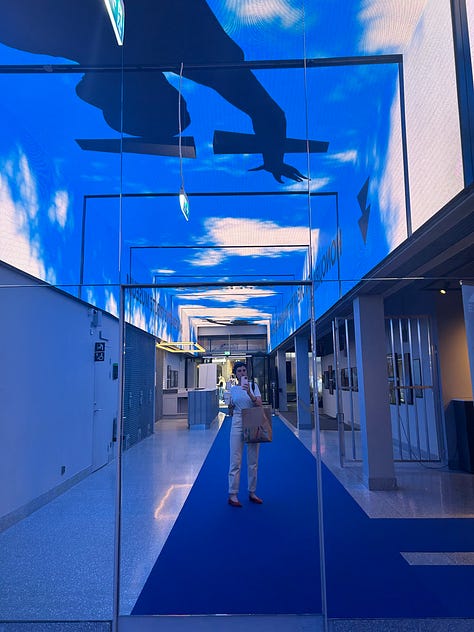
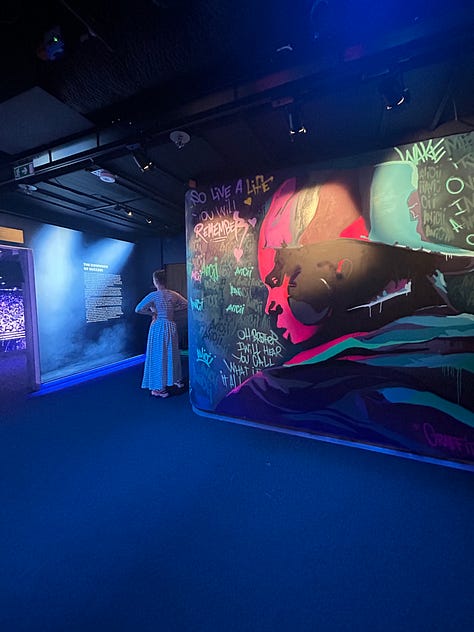
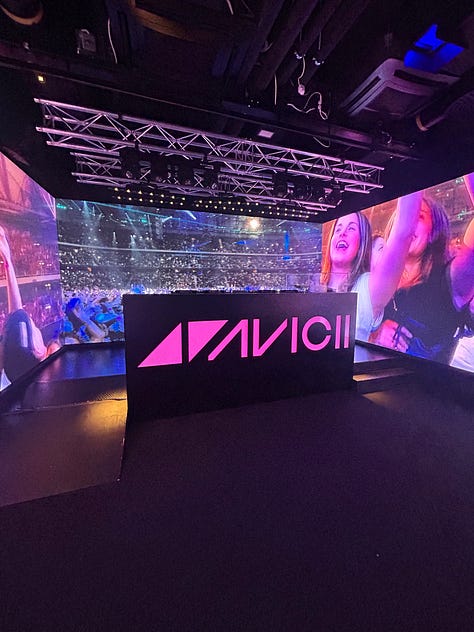
Towards the end of the experience, signed guest books are piled floor to ceiling. I pen a thank you to Tim for all the wonderful memories he helped create between my friends and I, remembering what it was like to be 18 in the passenger seat of my best friends car as Levels blares through the the sunroof–wild to think that was so long ago now.
Back at The Sparrow, and in the courtyard Anne the Art Historian From Breakfast and I share notes on our experiences from the day. I mention the Avicii exhibit and she pauses. At first, I wonder if she might consider this to be a ‘low brow’ experience but she elicits the opposite. We talk about musical and artistic resonance and individual taste. A brilliant chat that carries us on through dinner at Prinsen over Swedish meatballs.
Stockholm is pleasantly surprising.
There are moments when I wonder if the people here consider tourists deeply annoying. They certainly don’t make an effort to hide their disdain (lol) but there’s a richness to the culture doused in appreciation for beauty, history, and preservation that’s remarkable.
On my last day, I give myself a self-designated free day where I roam the city, explore more shops, and prompt a little spontaneity.
A satisfying day ends with dinner at Michelin-starred Babette for pizza. I order the spicy n’duja sausage pizza and snag a seat at the bar as the rain starts to hammer against the window. Lucky for me, I arrive early enough to skip the queue that now leads out the door and snakes around the corner.

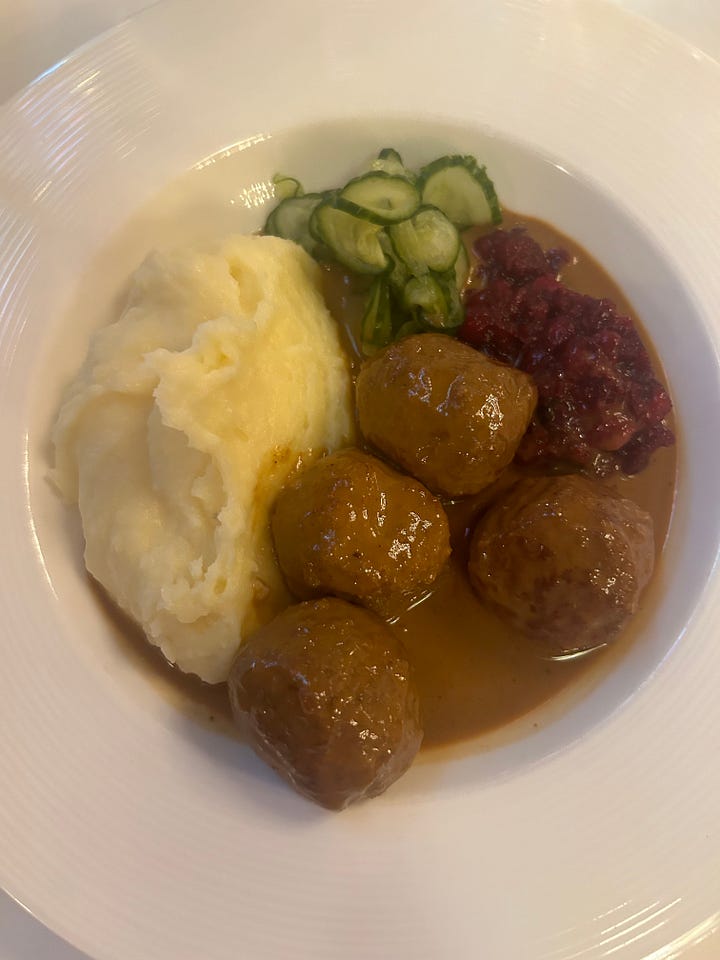

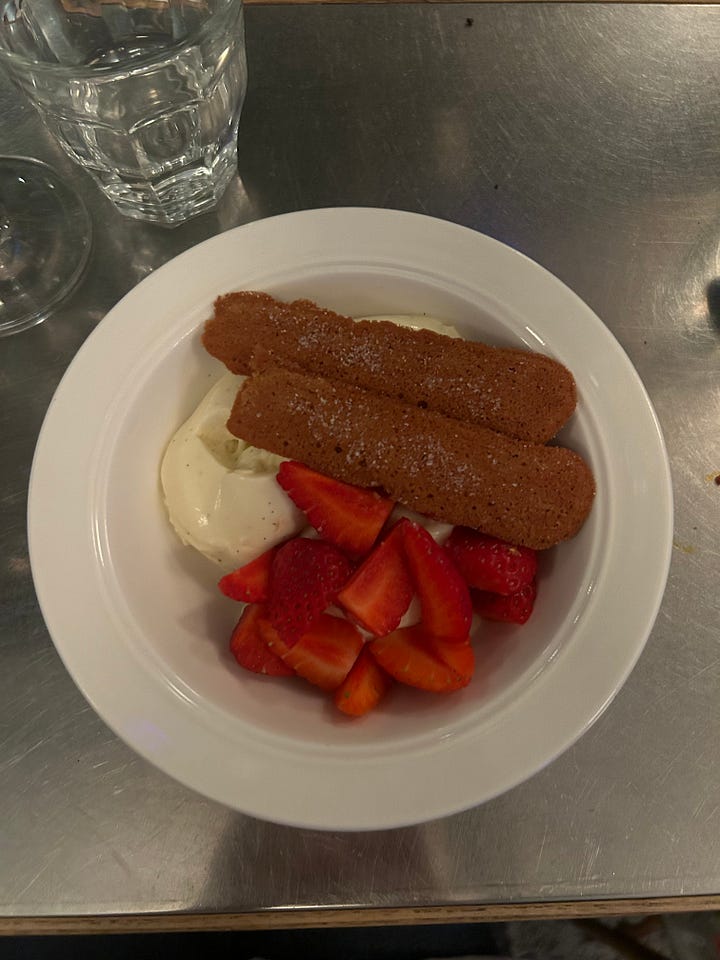
There’s something really quite satisfying about sitting in a dimly lit corner as you peer out the window at sideways rain knowing you’re fully protected. I wolf down my pizza in record time, the rain only slams the window harder.
I don’t want to leave yet, so I order another glass of wine.
More rain.
More wine, dessert appears, then disappears just as quickly.
Stockholm—came for the culture. Stayed for the pizza. Left due to rain.




